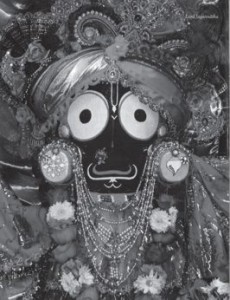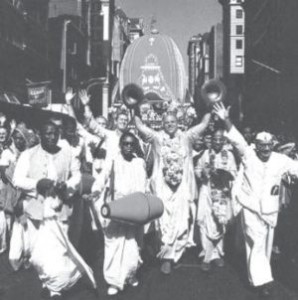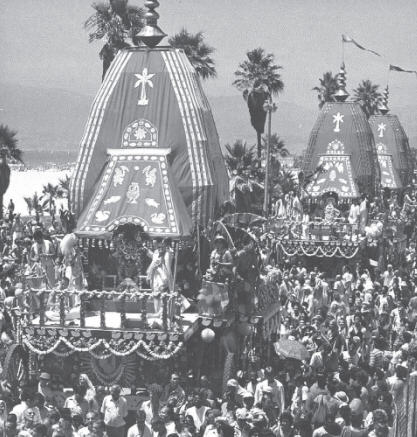In this world of bewildering material forms, Krsna appears as Jagannatha a transcendental form we can't forget.

Jagannathah swamI nayana· patha-gaml bhavatu me "0 Lord of the universe, kindly be visible unto me." Jagannathastaka Someone said that Lord jagannatha had arrived and was in Prabhupada's room. Srila Prabhupada was in San Francisco, so I went upstairs, and there was Lord jagannatha, a three-foot-tall, blackfaced, round-eyed, smiling Deity. Unfortunately, my first impression was one of resentment. 'Why did we have to worship such a strange form of God? I had already accepted from Srila Prabhupada that Lord Krsna was the Supreme Personality of Godhead, and I was faithfully fixed in that. I was attached to chanting the Hare Krsna mantra and to regularly hearing from the Bhagavad-gita. And I knew that Srila Prabhupada's mission to spread Krsna consciousness was also my life's mission. But why did we now have to worship Lord jagannatha? We had been doing fine with pictures of Krgla as youthfut attractive Govinda holding a flute and standing in a threefold· bending form beside SrImatl RadharanI and a cow. Why go from that to this primitive form of jagannatha?
Earlier, Srda Prabhupada had said that we should place jagannatha on the al tar in the storefront, so I realised that my skeptical feelings were crazy. I mostly gave them up, worshiped Lord jagannatha, and awaited Srila Prabhupada's return. In May, when Prabhupada was back with us, I asked him about Lord jagannatha. He expla ined that jagannatha is Krsna. He was carved in that form by the demigod.sculptor Visvakarma. Srila Prabhupada also explained that although a sculptor had fashioned jagannatha out of wood, He had consented to appear out of His own will; the sculptor had not commanded Him to do so. Lord jagannatha appeared along with His brother Balarama and His sister, Subhadra. Being Krsna, Lord jagannatha has a blackish face and carries a conch shell and a disc weapon. His form is sharp-angled and stubbyarmed because during the special pastime of His appearance, His sculptor, Visvakarma, left- by the plan of the Lord-before finishing is work. For further explanation, Prabhupada spoke the line jagannathah swami nayana-patha-gami bhavatu me. At my request, he then spoke it again, slowly, while I wrote down each word. Prabhupada said it was a prayer: "0 Lord of the universe, kindly be visible unto me." In this prayer, he said, the devotee is praying to see the spiritual form of the Lord. We are always seeing material objects, but the devotee prays to God in the form of the Deity of jagannatha that he may see Him as He actually is- the Lord of the universe. This explanation seemed wonderful and valuable. Now I could pray to Lord jagannarha with the right attitude.
INITIAL DAYS WITH JAGANNATHA

Jayapataka Swami Kirtan in Jagannath Rathyatra
One of the New York devotees began carving three-inch-high jagannarhas. We placed Him in a comfortable cloth pouch, and the pouch was affixed to the cord around our necks. When I wore Lord jagannatha around my neck and walked into my place of work, the New York City welfare office on East Fifth Street, it caused quite a stir. But I considered it a part of the essential paraphernalia or identity of a devotee to wear Lord jagannatha, to carry japa beads, and to have a shaved head and a sikha. And the jagannatha Swami prayer was also essential. The prayer was composed with sympathy for a devotee who could not easily see God, even in the form of Lord jagannatha. As Prabhupada had explained it, the spirit soul in the material world is bombarded by sense objects demanding attention. Certainly in New York City wherever I turned, there were hard barrages of material forms. I saw buildings of cement and wood and glass. Millions of flesh· and blood bodies covered with cloth moved back and forth before my vision. Somewhere there was a patch of sky, somewhere a tree, and always the art ificial, manufactured, manmade items, like asphalt roads, billboards of paper and steel and painted colours, heavy trucks, goods and gadgets in store windows, newspapers, and, every few feet, rubbish trash in cans, papers in the street, bottles, dirt etc. But jagannarha had appeared along with His prayer. And Prabhupada had explained that prayer. Now out of the plethora of material objects before me, I could look upon the small, available form of Lord jagannatha and see Krsna. I prayed that He would reveal Himself to me in this form. By philosophical, theo· retical knowledge, I could accept, on the basis of guru and sastra, that jagannatha was Krsna, and so I was worsh iping Him. But to worship with true feeling, a prayer was needed, requesting the Lord to please reveal Himself to the worshiper: jagannatha swami nayana-patha-gami bhavatu me. As I prayed to and handled Lord Jagannatha, I lost all resentment. Later in 1967, Srila Prabhupada asked me to go to Boston to help him begin another ISKCON branch. When I moved there and took employment as a welfare case worker, I continued to carry my three· inch Jagannatha Deity to the office. But since I was a new man and Boston was not as permissive as New York City, I kept Lord Jagannatha in a box.
My worship consisted mostly of bringing Him Out of the box at noon, when I would offer Him prayers and the contents of my lunch so that I could eat only Krsna-prasada. I remember sitting on a park bench in deep snow at Franklin Park Zoo and opening the box of Lord Jagannatha before my cup of Cottage cheese and bananas, and I can reo call looking at Him in spring and summer, at various locations as I traveled to see clients throughout the city. Sometimes I would bring Him out for a quick look- "jagannathah swamI nayana.patha. gamI bhavatu me" -and then return with a refreshed mind to the world of material names and forms. A tour storefront temple in Boston we had six- inch deities on the altar. When] wrote to Srila Prabhupada about my daily offerings of flowers and about my prayers to Lord Jagannatha, asking forgiveness for my mistakes, Prabhupada warmly approved. But when I locked up the Deities in the storefront and went to see Prabhupada in New York, he admonished me "What if you were to leave me alone in a room?" By his guidance I was drawn into a more serious relationship with the Deities.
JAGANNATHA IS FOR EVERYBODY
I have been describing Lord Jagannatha in terms of private worship and temple worship, but He is most celebrated for His public appearance during the Ratha·yatra. Srila Prabhupada was eager for the festival to start as soon as possible after Jagannatha first appeared in San Francisco. It is amazing to consider his daring in this attempt to bring Ratha.yarra to the West. There is no tradition of Deity worship in Western countries and little appreciation for Indian spiritualism. But somehow, the happy, melodious chanting, the delicious free feasts, the daneing devotees, the big. wheeled, colorful, silk· topped carts, and smiling Lord Jagannatha, Balarama, and Subhadrathe pageantry of it all-have appealed to the fun-loving, parade-going, peace and God.seeking spirit that exists in people worldwide.
Srila Prabhupada loved to repeat the good new about Ratha·yatra. The mayor of San Francisco declared it "Ratha· yatra Day" throughout the city. The po· lice chief of Berkeley commented, "It is not a window-breaking crowd." A newspaper in London printed a picture showing the cart as a "rival to Nelson's Column." Chicago, Philadelphia, New York, Los Angeles, Melbourne, Calcutta, Bombay-Prabhupada loved to name the cities where the Ratha·yatra festivals were held each year as evidence of the potency of the Krsna consciousness movement.
Lord Jagannatha was not meant for only a quick look by a lone devotee at his desk in the office, but He was for the millions in big cities, and His prasaclam was meant for mass distribution. The inconceivable auspicious effect of Ratha-yatra is described in the sastra: "A person who sees the Lord's Ratha-yatra festival and then stands up to receive the Lord can purge all kinds of sinful results from his body" (Brahmanda Purana).
DEITY IS KRSNA HIMSELF

Essential evidence for the truth of Deity worship can be stated in a few sentences. One of my favorite statements is given by Srila Prabhupada in Sri Isopanisad (Mantra 5, purport): "Even if the Lord appears before us l. in the form of material energy, it is quite possible for Him to convert this energy into spiritual energy. Since the saurce of the energies is one and the same, the energies can be utilized according to the will of their source. For example, the Lord can appear in the form of the areavigraha, a Deity supposedly made of earth, stone or wood. Deity forms, although engraved from wood, stone or other matter, are not idols, as the iconoclasts contend."
This explains the technique by which the Supreme Lord appears in material forms as the Deity. He has inconceivable potencies, and thus He can convert His material energies into spiritual energy. As to why Krsna does this, that is also nicely explained in the same purport.
"In our present state of imperfect material existence, we cannot see the Supreme Lord due to imperfect vision. Yet those devotees who want to see Him by means of material vision are favored by the Lord, who appears in a so called material form to accept His devotees' service. One should not think that such devotees, who are in the lowest stage of devotional service, are worshiping an idol. They are factually worshiping the Lord, who has agreed to appear before them in an approachable way. Nor is the area form fashioned according to the whims of the worshiper. This form iseternally existent with all paraphernalia. This can be actually felt by a sincere devotee, but not by an atheisr."
To make it clearer, Srila Prabhupada makes a simple analogy between the Deity and a mailbox. The government post office has mailboxes in many locations, and a person can post a letter in any of those mailboxes with the same efficacy as when he brings it to the main post office. "But any old box," writes Prabhupada, "or an imitation, which we may find somewhere, will not do the work." Similarly, Krsna has authorised the area-vigraha incarnation. He will accept service through the form of the Deity to be worshiped in the temple. It is for the convenience and accessibility of His devotee that He appears in this way. Often Christians object to Deity worship, and they say that their own scripture, the Bible, forbids it with the declaration not to worship graven images. The Krsna conscious reply to this is that the authorised Deity is not a graven image, in the sense that the Deity's form is not concocted. "Image means imagination," Prabhupada used to say. So the injunction against idolatry is also in agreement with the Krsna conscious conclusion against any form of concocted worship. But because the Absolute Truth is the Supreme Person, the original father, He has a form, and if He likes He can appear in that form, whether in the material or the spiritual world, out of kindness for those who aspire to worship Him in His appearance as the areil-vigraha.
The sweeping generalisation that all forms of Deity worship are idolatry is based on a lack of knowledge regarding the Supreme Lord's ability and desire to appear in these worshippable forms. One time a disciple of Srila Prabhupada's visited a Protestant church along with his five year old son, and the child, who was accustomed to seeing Radha-Krsna worship in the temple, made a spontaneous but significant remark.When he saw the plain, empty altar in the church, the first asked his father, "Why don't they have a Deity?" But before his father could reply, the boy said, "I know because they are not advanced enough yet." The boy was referring to fact that in ISKCON temples, worship of the Deity is not allowed until the temple organisation and community are established enough to maintain high standards of regulated worship. The five year old Krsna-bhakta saw the church as awaiting further advancement before the congregation could install the form of God.
In India, some groups adopt the stance that Deity worship is idolatry. Prabhupada would criticise their faulty logic. "They say that God is not in the temple, that God is everywhere. But if He is everywhere, then is He not also in the temple?"
There have been many blasphemies committed against Deity worship, as well as much mundane argument against God's presence in the arca-vigraha, but a sincere devotee keeps himself fixed in the parampara and continues to become purified by, whenever possible, directly serving, bowing before, dressing, bathing, and cooking for the Lord of the universe. In fact, whoever takes the authorised Deity form to be an idol is rejected by the Vedic scripture. Arce vsnau sila dhir … yasya va naraki sah: "Whoever sees the Deity in temple as an idol is condemned to a hellish condition." (Padma Purana).
Srila Prabhupada's teachings on the science of God, as well as Vedic verses that confirm Deity worship have solidified my own convictions. I have also drawn strength and inspiration from hearing of the reciprocation between the Deity and great devotees. To His pure devotee Madhavendra Puri, Lord Krsna appeared in a vision and told him where the Deity could be found and how He could be served. In the form of the Saksigopala Deity, Lord Krsna spoke to a pure hearted brahmana and then, to keep a promise, walked with him for hundreds of miles. There are innumerable other instances recorded in the authentic literature of Gaudiya Vaisnavism that testify that the Deity of Krsna is not a stone or brass idol but Krsna Himself. One should nott misunderstand Srila Prabhupada's statement, previously quoted, that those who worship the Deity are in the lowest stage of devotional service. The distinction is that a neophyte devotee sees the arca-vigraha as a representation of God, whereas a spiritually advanced devotee sees that the Deity is actually Krsna.
LORD CAITANYA'S DEALINGS WITH LORD JAGANNATHA
Lord Caitanya displayed intense ecstatic symptoms in relat ionship with the Deity of Lord Jagannatha. After becoming a sannyasi, Lord Caitanya journeyed to Jagannatha Purl and fainted in ecstatic trance upon seeing Lord Jagannatha. Lord Caitanya also revealed the confidential meaning of Ratha-yatra. Feeling the mood of separation from Krsna as experienced by the gopis, Lord Caitanya gazed upon Lord Jagannatha in His chariot and sang a song expressing the mood of Radharani Madhavendra Puri and Lord Caitanya were certainly great scholars of Vedanta, and they could defeat the greatest panditas in debates of philosophy and logic. Therefore, their realised experiences can never be taken as sentimentalism or fanatical idolatry. By their example, we should reverently approach the Deity in the temple and take the opportunity to praise Him in kirtanas and to serve Him with all our senses.
Srila Satsvarupa Dilsa Goswami is a former Editor in chief of Back To Godhead and the author of more than 100 books on Krsna consciousness including a six volume biography of Srila Prabhupada.



